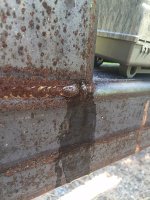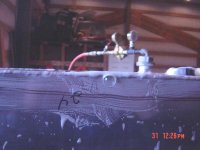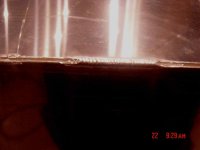Sodo
Elite Member
- Joined
- Apr 21, 2012
- Messages
- 3,197
- Location
- Cascade Mtns of WA state
- Tractor
- Kubota B-series & Mini Excavator
I was interested in the discussion about welding an item "tight" vs "weep hole". I was working on my gate yesterday and was looking at it, thinking about water and wondering if there was any inside it. My gate is welded "tight".
Drilled a hole and water poured out. It poured a lot more, that's how it looked by the time I dug the camera out. Recommend some folks drill drain holes in their "tight" implements and see what happens. Of course a little water in there might be more curiosity than problem (except near salt).
(EDIT: DELETED 2nd PIC with the large pee-stream BECAUSE i found where water can get in that one. The first one was welded tight, no nek'd eye visible entry points.
Drilled a hole and water poured out. It poured a lot more, that's how it looked by the time I dug the camera out. Recommend some folks drill drain holes in their "tight" implements and see what happens. Of course a little water in there might be more curiosity than problem (except near salt).
(EDIT: DELETED 2nd PIC with the large pee-stream BECAUSE i found where water can get in that one. The first one was welded tight, no nek'd eye visible entry points.
Attachments
Last edited:


